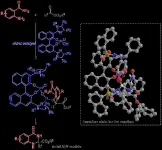(Press-News.org) Today, the average American is unlikely to spend time worrying about malaria. Although the disease is commonly perceived to be restricted to other parts of the world, it played a significant role in shaping American history. It even helped turn the tide of the American Revolutionary War by infecting so many British soldiers that General Cornwallis was forced to surrender at Yorktown.
First-year students in a 2019 introductory seminar class led by Erin Mordecai, an assistant professor of biology in the School of Humanities and Sciences (H&S), delved into this and other historical examples of how vector-borne diseases - those caused by infectious pathogens spread by living organisms or "vectors" - influenced human history. Throughout the course, they collaborated on a paper highlighting various trends in which these illnesses impacted historical societies. Their findings have now been published in the latest issue of the journal Ecology Letters.
"The mechanisms and consequences of vector-borne diseases are multimodal and far more pervasive than we had previously thought," said Tejas Athni, a student in the seminar and first author of the paper.
As Athni and his fellow students conducted their research, they discovered recurring themes across societies throughout time. One theme was that diseases don't affect all populations equally - a simple fact that had major ramifications throughout history. In the case of the American Revolution, many Americans had grown up in the South and were exposed to malaria young, allowing them to develop immunity. This granted them a strategic advantage over the less immune British army, which ended up being decimated by the disease.
A more sobering trend unearthed by the group's investigations was that disease tended to prey on inequities in societies, leaving marginalized groups most at risk. Both intentionally and unintentionally, it was weaponized time and again to enforce unjust hierarchies of power. In the American South, for instance, enslaved Black people were often forced to work in conditions that left them exposed to mosquitoes and made them much more vulnerable to malaria. To make matters worse, this inequity was used by white people to encourage the racist belief at the time that Black Americans were morally inferior and to justify Jim Crow segregation laws in the South.
Racism and disease
When Mordecai first submitted her class's paper for journal publication, it was rejected, with one reviewer citing the paper's failure to explore the relationship between racism and disease. Taking a more interdisciplinary approach, Mordecai then invited the reviewer, Nita Bharti, the Huck Early Career Professor of Biology at Penn State University, and Steven O. Roberts, an assistant professor of psychology in H&S and a race scholar, to speak to her class about systems of inequality from psychological and historical standpoints.
"We were taken aback by the extent to which the impacts of vector-borne disease have historically splintered across racial and societal lines," said Athni.
Structural racism, including what neighborhoods people can live in and their access to intergenerational wealth, is linked to disparities in rates of diabetes, hypertension and other chronic diseases associated with stress, Mordecai explained. These disparities are also apparent in the COVID-19 pandemic, where the disease's outcomes are more serious for individuals suffering with these conditions. This disproportionate burden further amplifies the vulnerability of already disadvantaged communities.
"When you layer on an emerging pandemic with existing health disparities, it disproportionally affects Black and Hispanic communities," said Mordecai.
Racial disparities also put historically marginalized communities at greater risk of being exposed to the virus. These communities, for instance, are more likely to be essential workers, lacking the luxury to safely shelter in place or have their groceries delivered.
"It's easy to think that communities of color aren't social distancing enough or not practicing proper hygiene," said Roberts, who is a co-author on the paper. "But that thinking completely neglects the social conditions that have made those communities more vulnerable to begin with."
The relationship between COVID-19 and structural inequality is unfortunately not limited to just modern times or the U.S. This too is a pattern that has repeated throughout history and across the globe. Outbreaks of leishmaniasis, a vector-borne disease spread by phlebotomine sand flies, have impacted hundreds of thousands of Syrians within refugee camps, a result of overcrowding in areas with poor sanitation. And when the first few cases of the Ebola outbreak popped up in 2014 in Africa, scientists in the United States were slow in finding ways to combat it until it showed up closer to home.
The authors hope that this paper will motivate scientists to be more proactive in protecting people in historically disadvantaged communities from disease.
"The paper does a spectacular job documenting the problem," said Roberts. "Now it will be important to maintain an interdisciplinary focus that can dismantle it."
Centering equity
Mordecai believes the paper produced as a result of her class is unique in the ecological literature. As the work underwent the peer review process, editors originally commented that it didn't feel like an ecological study at all. However, since the Black Lives Matter protests in the spring of last year, she said she is seeing a growing number of epidemiologists recognizing the role of racism in infectious disease transmission.
Athni, now a junior working on his honors thesis on statistically modeling the effects of climate on global mosquito distributions, said that being involved in this project has influenced the way he conducts research as a growing biologist.
"Dr. Mordecai's freshman seminar shaped my entire Stanford journey through an interdisciplinary lens," Athni said. "Moving forward, it's imperative that research explicitly recognizes and combats the structural racism, classism and sexism that continue to perpetuate environmental and health inequities. Equity must be brought to the center of ecology and global health in order to make meaningful progress for all of humanity."
INFORMATION:
Additional Stanford co-authors include Giulio A. De Leo, professor of biology and senior fellow at the Woods Institute for the Environment; Kathryn Olivarius, assistant professor of history; postdoctoral scholar Devin Kirk; former postdoctoral scholars Marta Shocket and Jamie Caldwell; graduate students Lisa I. Couper, Nicole Nova, Marissa Childs and David G. Pickel; and undergraduate and former undergraduate students Julian Cheng, Elizabeth A. Grant, Patrick M. Kurzner, Saw Kyaw, Bradford J. Lin, Ricardo C. Lopez, Diba S. Massihpour, Erica C. Olsen, Maggie Roache, Angie Ruiz, Emily A. Schultz, Muskan Shafat and Rebecca Spencer. Shocket is also affiliated with University of California, Los Angeles, Caldwell is also affiliated with University of Hawaii at Manoa and Kirk is also affiliated with the University of British Columbia. Researchers from James Cook University, University of California, Santa Barbara, University of California, Davis and Penn State University also contributed to the paper.
This research was supported by the Stanford Introductory Seminars Program, National Science Foundation, National Institutes of Health, the Helman Scholarship, the Terman Fellowship, the King Center for Global Development, the Huck Institutes for the Life Sciences at Penn State University, the Stanford Interdisciplinary Graduate Fellowship program, the Stanford Data Science Scholars, the Stanford Woods Institute for the Environment, the Stanford Institute for Innovation in Developing Economies, Global Development and Poverty Initiative, the Stanford Graduate Fellowship, the Ric Weiland Graduate Fellowship in the Humanities and Sciences.
Samara Polytech chemists investigated the potential anticarcinogenic effects of extracts obtained from plant materials of lingonberry, raspberry, black chokeberry, grapes, Krasnodar green tea, ginseng, fireweed and coffee, and also evaluated their effect on the growth and viability of colon cancer cells. The research was carried out within the framework of the state assignment for fundamental research No. 0778-2020-0005, its results were published Dec. 29, 2020 in the journal Proceedings of Universities. Applied Chemistry and Biotechnology (DOI: https://doi.org/10.21285/2227-2925-2020-10-4-613-626).
Prevention is the most cost-effective and long-term strategy for controlling this disease. It is now well known ...
A lot of our medicines and other bioactive drugs are based on chemical structures called "enantiomers"-- molecules that are mirror images of each other and are non-superimposable. Notable among them are chiral N,N-acetals contained in diuretic drugs like bendroflumethiazide and thiabutazide, used to treat high blood pressure and edema. Because an enantiomer and its mirror image version often have different biological activities, with only one of them having pharmacological utility, an "enantioselective" or asymmetric synthesis yielding the desired enantiomer in greater amounts is highly desirable.
In the case of N,N-acetals, several studies have demonstrated their enantioselective preparation from aldehydes, aldimines, or enamines. However, in all these cases, ...
CLEVELAND (Feb. 9)--A study led by Case Western Reserve University researchers found that patients with dementia were at a significantly increased risk for COVID-19--and the risk was higher still for African Americans with dementia.
Reviewing electronic health records of 61.9 million adults in the United States, researchers found the risk of contracting COVID-19 was twice as high for patients with dementia than for those without it--while among those with dementia, African Americans had close to three times the risk of being infected with COVID-19 as Caucasians did.
In addition, patients with dementia who ...
KEY STUDY FINDINGS INCLUDE:
2.9% of U.S. adults report a current peanut allergy.
About one in six adults with a peanut allergy developed it after age 18.
Approximately one in five adults with peanut allergy report visiting the emergency department for food allergy treatment each year.
Patients who developed their peanut allergy during adulthood are less likely to report having an epinephrine auto-injector prescription than those who developed their peanut allergy during childhood, despite similar frequencies of severe reactions among both groups.
CHICAGO --- Peanut allergy affects at least 4.5 million adults in the U.S., many of whom report developing their ...
Researchers at Baylor College of Medicine and other institutions have identified a novel strategy that can eliminate bacteria in a specific location before they cause an infection. The strategy uses a phage, a virus that infects and destroys bacteria, that can specifically locate in the same place the bacteria live in the gastrointestinal tract. The proximity between phage and bacteria facilitates the phage's attack and subsequent elimination of the bacteria.
This strategy has the potential of becoming a game changer in the fight against antibiotic-resistant bacteria ...
DALLAS, Feb. 9, 2021 -- Participants in a two-year, lifestyle intervention/weight-loss program provided through health coaches at their primary care center were able to lower their blood sugar and improve their cholesterol levels, according to new research published today in the American Heart Association's flagship journal Circulation Journal. Researchers with the PROmoting Successful Weight Loss in Primary CarE in Louisiana (PROPEL) Trial reported previously that participants also reduced body weight by an average of 5% and note that patients who lost more weight experienced greater improvements in their heart disease risk factors.
"Our results demonstrate lifestyle intervention and weight-loss programs can be successful for people in underserved, low-income ...
DALLAS, Feb. 9, 2021 -- Dietary information from three large, well-known heart disease studies suggests drinking one or more cups of caffeinated coffee may reduce heart failure risk, according to research published today in Circulation: Heart Failure, an American Heart Association journal.
Coronary artery disease, heart failure and stroke are among the top causes of death from heart disease in the U.S. "While smoking, age and high blood pressure are among the most well-known heart disease risk factors, unidentified risk factors for heart disease remain," according to David P. Kao, M.D., senior author of the study, assistant professor of cardiology and medical director at the Colorado Center for Personalized Medicine at the University of Colorado School of Medicine ...
In 2017, a widely cited study used statistical tools to model how likely the world is to meet the Paris Agreement global temperature targets. The analysis found that on current trends, the planet had only a 5% chance of staying below 2 degrees Celsius warming this century -- the international climate treaty's supposed goal.
Now, the same authors have used their tools to ask: What emissions cuts would actually be required to meet the goal of 2 C warming, considered a threshold for climate stability and climate-related risks such as excessive heat, drought, extreme weather and sea level rise?
The University of Washington study finds that emissions reductions about 80% more ambitious than those in the Paris Agreement, or an average of 1.8% drop in emissions per year rather than 1% ...
New research led by Monterey Bay Aquarium reveals that even the revered white shark cannot escape the impacts of a changing ocean. The study, published in Scientific Reports, finds that unprecedented sightings of juvenile white sharks at the northern end of Monterey Bay signal a significant shift in the young white sharks' range.
Researchers conclude the northward range shift demonstrates the young sharks are being subjected to a loss of suitable thermal habitat, meaning water temperatures within their preferred temperature range are becoming harder to find.
"Nature has many ways to tell us the status quo is being disrupted, but it's up to us to listen," said Monterey Bay Aquarium Chief Scientist Dr. Kyle Van Houtan. "These sharks - by venturing into territory where they have not historically ...
Our consumer products, such as food, cosmetics and clothes, might be filled with nanomaterials - unbeknownst to us. The use of nanomaterials remains unregulated and they do not show up in lists of ingredients. This is a cause of concern since nanomaterials can be more dangerous than COVID-19 in the long term if no safety action is taken: they are tricky to measure, they enter our food chain and, most alarmingly, they can penetrate cells and accumulate in our organs.
Nanotechnology is appearing everywhere, to change our daily lives. Thanks to applications of nanotechnology, we can treat many diseases so efficiently that they'll soon be a thing of the past. We also have materials that are 100 times stronger than steel, batteries that last 10 times longer than ...



